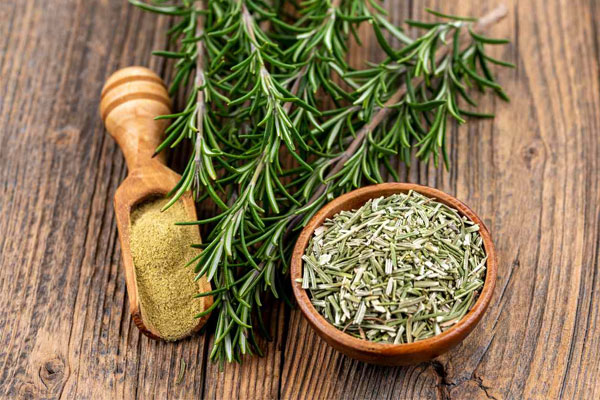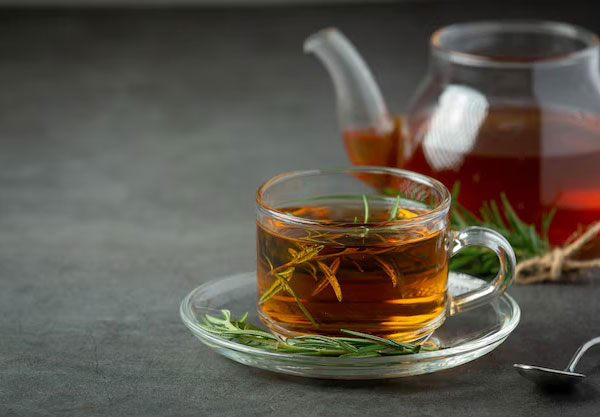Blogs
Is it better to use fresh or dried rosemary for tea?
Rosemary tea is a popular herbal infusion known for its earthy aroma, refreshing taste, and numerous health benefits. Whether used to support digestion, boost circulation, or provide antioxidants, rosemary has long been valued for its medicinal properties. However, when making rosemary tea, many people wonder: Is it better to use fresh or dried rosemary?
Both fresh and dried rosemary have unique characteristics that affect flavor, nutrient content, and convenience. Some prefer the light, delicate taste of fresh rosemary, while others enjoy the stronger, more concentrated infusion of dried rosemary. But which one is truly the best for tea?
This article will compare the differences between fresh and dried rosemary, examining their nutritional value, taste, brewing qualities, and overall benefits to help you decide which option best suits your needs.

Differences between fresh and dried rosemary
When choosing between fresh and dried rosemary for tea, it’s essential to understand how they differ in appearance, flavor, nutrient content, and brewing qualities. Each form of rosemary has distinct characteristics that can impact the overall tea-drinking experience.
Appearance and texture
- Fresh rosemary: Bright green, needle-like leaves with a soft, pliable texture due to high moisture content.
- Dried rosemary: Darker green or slightly brown, brittle, and more concentrated due to moisture loss.
Flavor and aroma
- Fresh rosemary: Mild, herbal, and slightly earthy flavor with a fresh, grassy aroma.
- Dried rosemary: More potent and concentrated, sometimes slightly bitter due to intensified essential oils.
Nutrient content
- Fresh rosemary: Contains higher levels of water-soluble vitamins (like vitamin C) and delicate antioxidants.
- Dried rosemary: More concentrated in essential oils and polyphenols due to moisture evaporation, but may lose some heat-sensitive nutrients.
Brewing and infusion strength
- Fresh rosemary: Produces a lighter, milder tea that may take longer to steep.
- Dried rosemary: Infuses more quickly and strongly, resulting in a richer and more aromatic tea.
Understanding these key differences can help you decide which type of rosemary best suits your preferences and health goals when making tea.
Pros and cons of using fresh rosemary for tea
Using fresh rosemary for tea has its own unique advantages and drawbacks. While it provides a lighter, fresher taste and retains more delicate nutrients, it may not always be the most convenient choice.
Pros of using fresh rosemary for tea
- Milder, fresher flavor – Fresh rosemary has a softer, more subtle taste that is less overpowering than dried rosemary, making it ideal for those who prefer a gentle herbal infusion.
- Higher water-soluble nutrients – Fresh rosemary retains more vitamin C and delicate antioxidants, which can be lost during the drying process.
- Less bitter – Since fresh rosemary has more moisture and less concentrated essential oils, it results in a smoother, less bitter tea.
- Aesthetic appeal – Fresh rosemary sprigs can make your tea look more visually appealing and aromatic.
Cons of using fresh rosemary for tea
- Shorter shelf life – Fresh rosemary wilts quickly and needs to be used within a few days to a week, while dried rosemary can last for months.
- Weaker infusion – Because it contains more water, fresh rosemary releases its flavors and nutrients more slowly than dried rosemary, requiring longer steeping times.
- Less convenient – Using fresh rosemary requires washing and chopping, whereas dried rosemary is ready to use straight from the jar.
Overall, fresh rosemary is an excellent option if you prefer a milder, nutrient-rich tea with a fresher aroma, but it may not be the best choice for those looking for stronger flavor, convenience, or long-term storage.
Pros and cons of using dried rosemary for tea
Dried rosemary is a popular choice for making herbal tea due to its stronger flavor, longer shelf life, and convenience. However, drying can affect some of its nutrients and make the tea slightly more bitter. Below are the key pros and cons of using dried rosemary for tea.
Pros of using dried rosemary for tea
- Stronger flavor and aroma – Drying concentrates rosemary’s essential oils, resulting in a more robust, aromatic tea with a deeper herbal taste.
- Longer shelf life – Unlike fresh rosemary, dried rosemary can last several months to a year when stored properly, making it more practical for long-term use.
- More convenient – Ready to use without washing or chopping, making it quicker and easier to prepare tea.
- Infuses faster – Because it has less moisture, dried rosemary releases its compounds more quickly, creating a stronger infusion in less time.
- Widely available – Dried rosemary is easier to find in stores and can be used anytime, even when fresh rosemary is out of season.
Cons of using dried rosemary for tea
- Can be more bitter – Since dried rosemary is more concentrated, it can sometimes have a slightly bitter or overpowering taste, especially if over-steeped.
- Some nutrient loss – Heat-sensitive nutrients like vitamin C may degrade during the drying process, although it still retains beneficial antioxidants and essential oils.
- May contain additives – Some store-bought dried rosemary may have preservatives or contaminants, so it’s best to choose organic, high-quality dried rosemary.
Overall, dried rosemary is ideal for those who prefer a stronger, more aromatic tea with convenience and long shelf life, while fresh rosemary is better for those who enjoy a milder, more delicate infusion.
Tips for brewing the best rosemary tea
To get the most out of your rosemary tea, whether using fresh or dried rosemary, follow these tips to enhance flavor, aroma, and health benefits.
Choose high-quality rosemary
- For fresh rosemary: Use organic, pesticide-free sprigs with vibrant green needles for the best taste and nutrients.
- For dried rosemary: Opt for organic, high-quality dried rosemary with no additives or preservatives for a pure, natural infusion.
Use the right amount
- Fresh rosemary: Use 1–2 sprigs (about 1 tablespoon of leaves) per cup of water.
- Dried rosemary: Use 1 teaspoon of dried rosemary per cup of water since it is more concentrated than fresh.
Proper steeping time
- Steep for 5–10 minutes in hot but not boiling water (about 190–200°F or 88–93°C) to avoid bitterness and preserve beneficial compounds.
- For a stronger tea, steep longer, but keep in mind that over-steeping can lead to a more bitter taste.
Enhance the flavor
- Add honey or lemon for a touch of sweetness and freshness.
- Combine with mint, chamomile, or ginger to balance the herbal notes.
- Add a cinnamon stick for a warm, slightly spicy twist.
Strain properly
- For fresh rosemary: Use a fine-mesh strainer or tea infuser to remove the leaves.
- For dried rosemary: Since dried leaves can be small, a tea ball infuser or paper tea bag helps prevent residue in the cup.
Experiment with cold brew. For a smoother, less bitter tea, try cold brewing: Add rosemary to cold water and let it steep in the fridge for 6–12 hours before straining and serving.
Store it right
- Fresh rosemary: Keep in the fridge, wrapped in a damp paper towel, or freeze for long-term use.
- Dried rosemary: Store in an airtight container away from heat and light to maintain flavor and potency.

Conclusion
Both fresh and dried rosemary can make a delicious and health-boosting tea, but the choice depends on your taste preferences, convenience, and nutritional goals.
- Fresh rosemary offers a milder, more delicate flavor and retains more heat-sensitive nutrients, making it a great option for those who prefer a light, refreshing tea with maximum nutritional benefits.
- Dried rosemary, on the other hand, has a stronger, more concentrated flavor, a longer shelf life, and is easier to store and use, making it the more convenient choice for regular tea drinkers.
Regardless of which type you choose, following the best brewing practices such as using the right amount, steeping at the proper temperature, and experimenting with flavor combinations can help you enjoy the full aroma, taste, and health benefits of rosemary tea.
Ultimately, there is no right or wrong choice fresh or dried, rosemary tea is a simple and natural way to support overall wellness. Try both and see which one suits your preference best!
